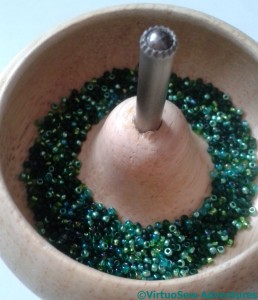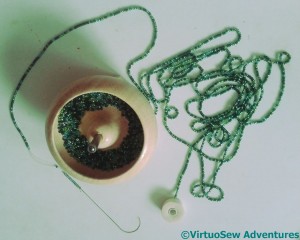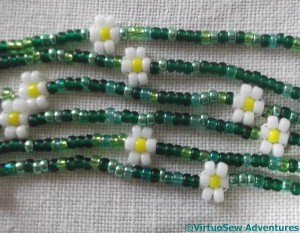Learning a new technique
In “Nefertiti Lived Here” Mary Chubb describes excavating a necklace, and being reminded of a bead necklace she had as a child, partly by the delicacy of the necklace she was working on, and partly because the fact that she had no idea where it had gone gave some insight into how the excavated necklace could have been lost in antiquity.
Of course, she didn’t describe the necklace very much – she only said it had daisies on it – but I want to include some trails of daisy embellished lengths of beading, hanging off the edge of one of the Dreams of Amarna panels. Beadwork is not a technique I’m very familiar with, so it’s yet another adventure into the unknown!
I wanted to make sure that there was some variety of colour in the green strands, and I used this “bead-spinning” pot to thread a random selection of green seed beads onto a strand. I got a little carried away here, because it took me some time to get used to the technique. I discovered that, strongly right handed though I am, it was more successful to hold the needle in my left hand, and turn the spindle with my right. In the end I had at least a couple of metres of bead strand waiting to be used, and I still have a metre left!
Here is a close up of the beaded strands I have created, with very simple bead daisies interspersed with lengths of the green beads. I’m rather pleased with it. It has the sort of delicacy that would have been considered suitable for a little girl in the early years of the twentieth century, and I can just imagine a small Mary gleefully rattling her beads and feeling very grown-up!




Oh — what pretty beads!
Oh, it’s lovely. But I’m a little confused…. How did you end up with the little daisies on the thread of green beads, when your original string shows no daisies, just a long thread of green seed beads?
Your simple little daisy pattern is very effective.
Those are very pretty, and all the better for a bit of randomness. Lots of elderly embroidery books have instructions for daisy-chain necklaces of various degrees of complexity. (By coincidence, I noticed some last night while looking through Weldons Encyclopedia of Needlework for something else.) Stringing beads in a simple manner, like your plain green strings is very restful. I’m not a ‘jewellery person’ but I like one or two simple strings of small beads to enliven a plain jumper. And as a bonus I get all sorts of interesting tinkles and clatters from the vacuum cleaner the next time I clean up my work area.
That’s pretty with daisies. Quite new to me to use a spinning. I’m curious of how it works.
how lovely! so dainty….
I haven’t seen a bead spinner before – I usually just tip mine on to a piece of felt and mix them. Your little daises are lovely – I would have loved a necklace like that when I was little!
You’ve gotten our curiousity up over the bead spinner — please show us more. It looks like a wonderful contraption.
Those are pretty beads. I am new to beading and I haven’t seen a bead spinner before. Does it stop you dropping them on the floor?
What a lovely, whimsical touch. Armana is starting to remind me a bit of a stumpwork casket, with all the different techniques.
The daisies are delightful. Fascinated by your bead spinner, which is is new to me too. I use some tiny metal ‘scoop’ dishes I bought from a wonderful bead/jewelry workshop in Torquay.
great to see you trying a new technique. I love my bead spinner, it’s invaluable for stringing long strings of seed beads. Love the little daisies and I look forward to seeing them insitu. daisy bracelets and rings, just like your strands above, were very en vogue when I was a young teenager, and that wasn’t at the turn of the 20th century!